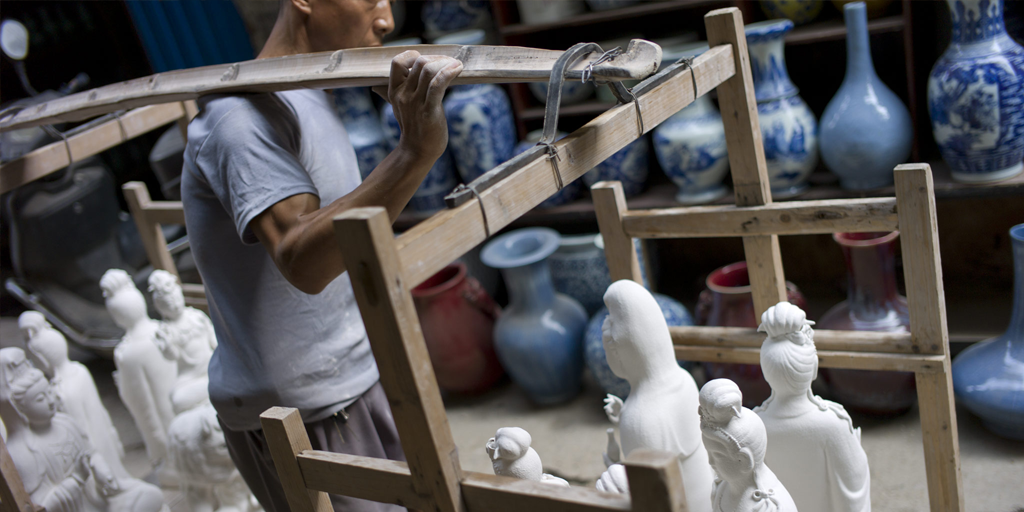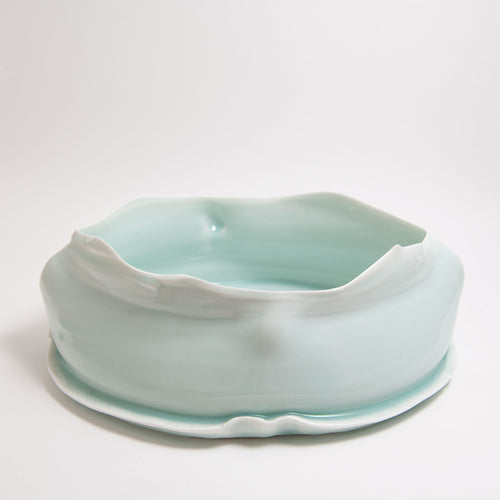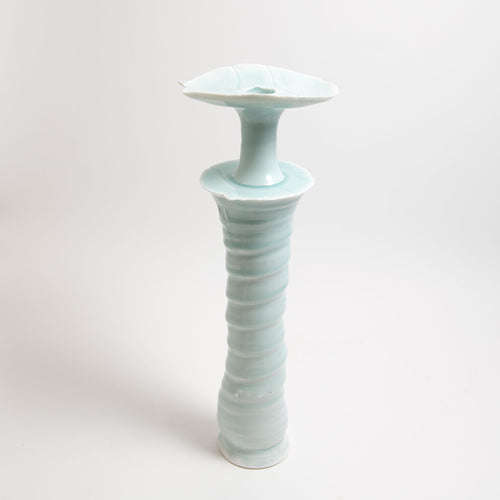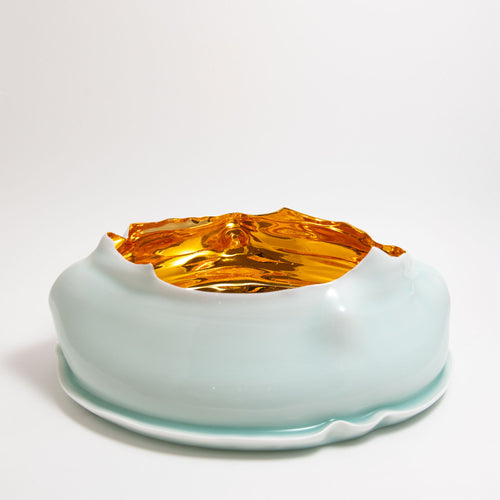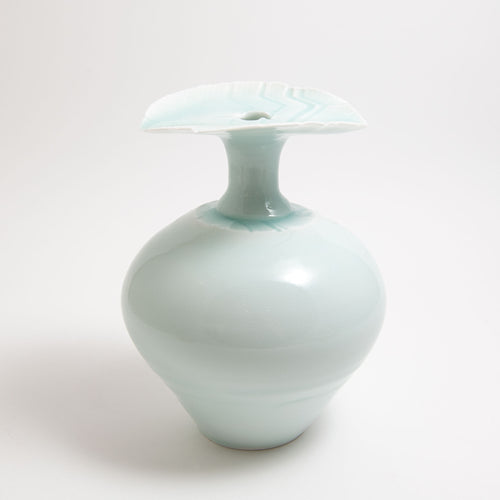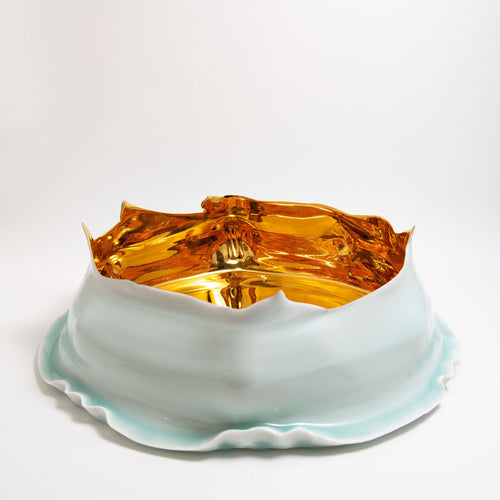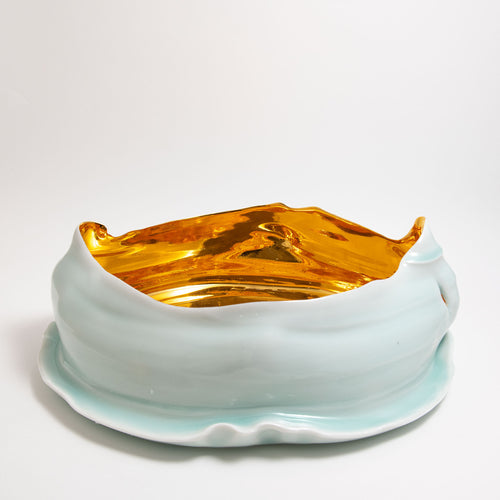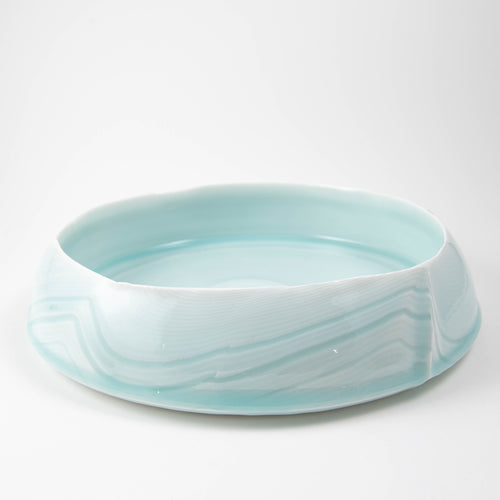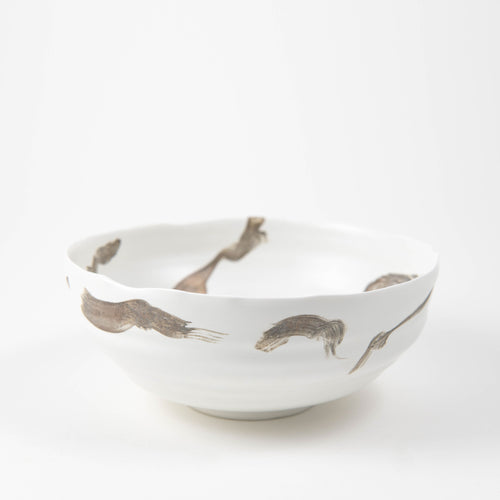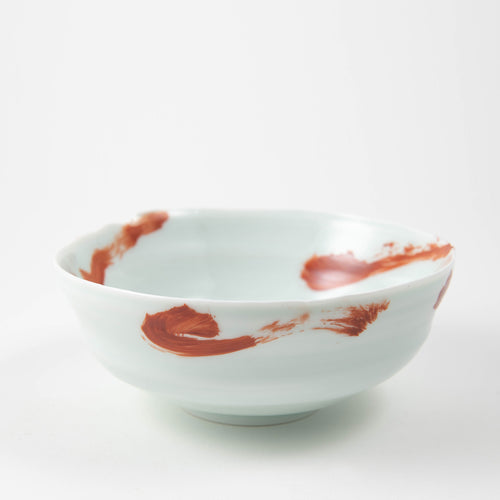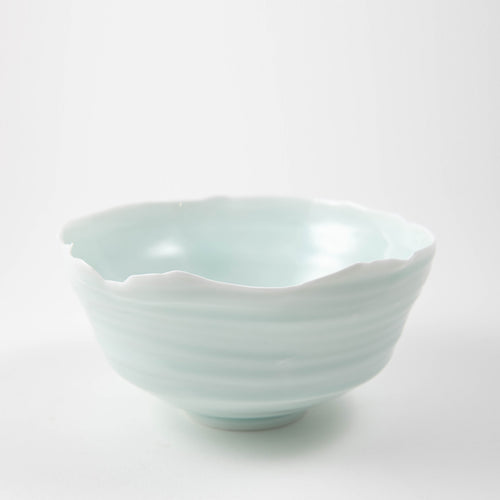It is now a decade since the Goldmark film crew first visited Jingdezhen, China’s ‘Porcelain Capital’, to film the British-Japanese potter Takeshi Yasuda at work. He has had studios in the city for twenty years; this year he will be 80. But in Jingdezhen, as our film crew found out, words like past and present, real and fake, industrial and handmade are not as distinct as they might seem. We reflect on what was an extraordinary, eye-opening trip.

Jingdezhen’s vital porters transport pots at different stages of completion through streets lined with antiques shops

An eight-strong team roll out a vast porcelain tile
Low slung above the streets of Jingdezhen, fat bundles of electrical cabling line the lips of overhanging shopfronts like nerves along limbs, occasionally meeting in a teeming mass of wiring. Takeshi Yasuda, a Japanese-born British potter with a studio in the city, points to an especially messy meeting point. ‘Those cables’, he laughs ‘– half of them are redundant. But you can’t do anything about it, because nobody knows which is supporting what.’

Jingdezhen’s vital porters transport pots at different stages of completion through streets lined with antiques shops
This year marks twenty since Yasuda first came to Jingdezhen, and ten since Jay Goldmark led a two-man film crew to document his life in the self-proclaimed ‘Porcelain Capital of the World’. Here Jay found a place so alive with activity and regeneration that he fell into a ‘flow state’, where the photography came easy. ‘It was a gift. You couldn’t take a picture and not get something interesting. All your senses were heightened: the smells, the constant noise of traffic, food being cooked every-where, the markets, some of which were almost medieval. It was visceral.’ Looking back at this strange, compelling city, these networks of tangled wires are just one of a thousand irresistible allegories. They hint at a place of constant exchange, contradiction and confusion: a historical crossroad, where the old clings to the new, where bona fide and counterfeit are indistinguishable, and where the past has become a priceless currency.

A view over Jingdezhen from Takeshi Yasuda’s studio
It is said that the people of Jingdezhen live and breathe porcelain. Emerging from his taxi as he arrived in the city, Jay was to discover this was quite literally true. ‘My first impression, the first thing that hit me, was just dust. Clay dust. You could taste it in the air, and in lots of my pictures you can see there is this sort of white powder everywhere.’

Yasuda assembling a twisted Lily Vase form
This is the ‘white gold’ with which Jingdezhen was blessed, and on which it built its international reputation in the early 13th and 14th centuries, becoming one of the very first truly global cities of the early modern world. Pots have been made here for many hundreds of years, but it was a little over 1,000 years ago that the Emperor Zhenzong – who gave his name to the city – took note of the porcelain wares made in the area, declared his patronage, and demanded supply for his imperial court.

A worker moves kaolin and china clay to be ground by water powered hammers to his right
Seated on the valley plain of the nearby Poyang Lake, two local ingredients ensured Jingdezhen’s long-lasting success: an abundance of high quality ‘petuntse’ china stone and kaolin in the surrounding mountains, which when ground and mixed produced an exceptionally fine, strong, translucent porcelain clay. Tributaries of the nearby river Chang (we know it as the Yangtze) helped power the large hammers that crushed the locally mined stone and allowed transportation to Jingdezhen and beyond, outside the landlocked province of Jiangxi, and eventually around the world. Imperial favour drove further demand and before long, Jingdezhen had become an industrial hub whose wares were shipped, bartered and broken in every corner of the globe.

A mother and son ride past some porcelain street furniture in Jingdezhen city
For several centuries, Jingdezhen was the most productive ceramic centre in the world. Independent workshops rose alongside state-sponsored kilns, keen to capitalize on the city’s growing reputation – signs of an entrepreneurial spirit that would ensure Jingdezhen’s survival in more difficult times. But by the 19th century, with fierce internal and international competition, the costs of over-production were increasingly clear to see: mountains bored through for clay, forests razed for wood, streams choked with industrial pollutants, and the air thick with not just white dust but the smoke from its many kiln’s chimney stacks, too. Quarried hollows, in some cases 500 metres across and over 50m in depth, are today overgrown with moss and marshland: nature has begun to reclaim her territory. But the city’s greatest hubris is also the least conspicuous: a missing peak along the Gaoling mountain ridge, where kaolin gets its name, its seams so thoroughly exhausted that it eventually imploded – though not before distributing tonnes of debris onto the farmlands below.

Moulded Mao-morabilia in a Jingdezhen warehouse
When China ditched its imperial leaders in the early 20th century, Jingdezhen’s supremacy was already waning. With no courtly custom, today it provides for a completely different kind of hagiography. Hand-painted models of Chairman Mao, who began his ‘Long March’ in the mountains of Jiangxi, still proliferate in workshops and antiques stores. Disney – a 21st century empire of another kind – is a client. But while China emerged revitalised from its turbulent post-imperial, post-revolutionary phases, Jingdezhen has struggled to maintain its relevance. As recently as the 1990s, the city was largely dependent on cultural tourism, still trading on its thousand-year legacy. Its state-owned companies had lost their government protection, and what little trade Jingdezhen had retained, besides its coveted antiques, was increasingly lost to bigger competitors.

Hand painted Maoist figures
That all seems poised to change. Looking skyward, past the wires, dust and smoke, the mountainous horizon that surrounds the city is interrupted first by colossal chimney stacks and, more recently, the appearance of multistorey buildings and moving cranes. Jingdezhen is a city on the rise again. Recently designated ‘a centre for innovation’ by municipal officials, its upward growth is matched only by the furiously intense activity in its artists districts below. ‘You could feel the place changing while we were there,’ Jay remembers. ‘It was incredible – huge apartment blocks emerging around the city as we drove. Takeshi told us they’re just going up, and up, and up.’

Ancient buildings with a high-rise backdrop
Yasuda has been working here since the early 2000s, when he was invited to take over as Director of the Pottery Workshop, a post he held for seven years before setting up his own studio. In that time he has seen state money flood into the city – and, perhaps more surprisingly, people too. Today young natives of China’s largest cities, depressed by the routines of city life, look to Jingdezhen as the ideal country destination to begin a career in craft or design. It’s a fact that highlights the extraordinary difference in scale and perspective for a tourist from the UK. Jingdezhen and its satellite villages are home to more than 1.5 million people – a population larger than Birmingham. But as Jay points out, the city is surrounded by greenery: plantations, rice paddies, and the looming pine forests, with recently planted bamboo restoring some of the lost habitats of the mountain basin.

Young students out window shopping at the weekend
Centuries of innovation in the field of porcelain has established here a vast ecosystem of specialist workers, each one dependent on the skills of the rest. It was this knowledge base that convinced Takeshi to take up his directorship. ‘After nearly 40 years of stoneware,’ he recalls, ‘I thought “I can teach myself porcelain.” But I was really struggling. Porcelain clay doesn’t behave like stoneware clay or earthenware clay. So all the skills I had learnt and developed over these years just didn’t work. And then came the opportunity to come to the “Porcelain Capital”, Jingdezhen, and I thought I can learn something here.’

Takeshi Yasuda with a porcelain stemmed cup, thrown in two pieces
Not all porcelain is made equal. Grittier than its buttery grey appearance would have you believe, most porcelain clays are thixotropic (like quicksand, they become runnier the more they are agitated) and pyroplastic (meaning they soften at the highest temperatures of a firing). But the geology that formed Jingdezhen’s treasured kaolin deposits produced a material that, once combined with china stone, made a clay blend more plastic than any other porcelain in the world. This clay could be worked to dramatic extremes without collapsing in a sticky heap, making the impossible possible for the potters of Jingdezhen: incredibly large or thin, translucent vases, dishes and bowls that seemed to radiate with the light filtering through their surface.

Baixu, Takeshi Yasuda's assistant, admires huge vases destined for glazing
These antiques are still one of the city’s main exports. Whole pots, in good condition, can fetch millions in private and public sales. And their scarcity has given rise to a whole industry of counterfeits, some near inseparable in appearance – and quality – from the original.

Entrance to the 'fake' antiques market
An otherwise unassuming backstreet brought Jay to one of the district’s many antiques markets. ‘Or fake antiques market, as it is known here’ remarked Takeshi. ‘This is a very interesting area because the history of making fake antiques is indeed very, very old. Older than lots of antiques themselves, actually. Reproducing old artifacts is a proper Chinese activity.’ Mao-morabilia line the shelves of one shop, huge white-and-blue ware vases another, muddied with a special ochre concoction applied to make new arrivals from the surrounding workshops into ‘instant antiques’. ‘Often this antiquation they do in front of their shop’ Takeshi says, smiling. There is a certain pride taken here, not just in deceiving even the most scrutinising of experts and matching the masters of old, but in sustaining the network of skills that have kept the magic of Jingdezhen’s porcelain trade alive.

Exhausted porters enjoying a well-deserved break
Vital to this activity are a cadre of porters who by foot, trolley, and moped supply the various studios with work. ‘Jingdezhen is an amalgamation of hundreds or thousands of small workshops that all specialise in one skill,’ Takeshi tells us, ‘so pots have to move from one workshop to another constantly. These porters are a very important occupation, and there are several different modes of transport because each stage of pot has to be carried in a different way. Some haven’t changed for a thousand years.’

A specialist turns a huge cylindrical column on the wheel
Elsewhere, however, in tucked-away compounds and complexes, there are signs of the innovation that is bringing Jingdezhen’s past into the present: enormous porcelain columns, formed from six or seven precariously joined cylinders, are turned on the wheel in one workshop while vast 3 or 4 metre-wide tiles, each one requiring seven or eight men to roll them to the required thickness, are made in another. These spectacular forms, until only recently impossible to produce and which might once have graced the emperor’s palace are now destined for the new arenas of power in 21st century China: government offices, civic buildings and five-star hotels, where the demand for bigger, flashier pieces is ever growing.

Takeshi Yasuda gold bowl
In this environment where past and present, real and fake, industry and handicraft are fluid terms, incapable of describing the scale and scope of Jingdezhen’s enterprises, you cannot help but embrace its contradictions. Yasuda’s career began with the most orthodox of auspices: in 1963 he came to work in Mashiko and in 1973 left for the UK, intent on becoming ‘a so-called studio potter’ at the height of the second wave of the Leach revival movement. But like his twisted vases and torn-lip bowls, he has always been one to stretch and bend conventions to his advantage, or even throw them on their head: ‘When I came to England, the potter’s wheel was the tool you should avoid if you wanted to be anybody except Leach school. All these arguments going on, traditionalist and modernist, I felt were – well, I shouldn’t say this, but – juvenile. It’s not the limitation of the wheel itself; the wheel is only a tool. If mass production is not the aim, in fact you can use the wheel in all sorts of other quite extraordinary and inefficient ways. The wheel was a tool still to be discovered – that was my experience.’

Takeshi Yasuda's incredible method of achieving the rims of his special bowls
Though clays and glazes are produced locally here, Jingdezhen is, in a great many ways, the nightmare of the truth-to-materials traditionalist. You can make anything here and not know a thing about ceramics, as Takeshi points out. ‘Every craftsman will work with your instruction. You don’t need to be a sculptor, or a modeller; you could just give a simple drawing, and then a craftsman will make it three-dimensional. If you’re satisfied with it, you hand it over to a mould maker who will make you a mould, and a press moulder, who will cast it for you. You might decide to finish the details yourself, or you could ask somebody else. Then take that to the glazer, who will glaze it with whatever glaze you want, and then to the kiln people who will fire it. It’s an amazing place.’

Hand painting designs onto pots made elsewhere in the city
Yasuda largely operates outside of this network: he is a specialist with his own equipment, his firing needs too specific for the standardisation of most commercial workshops. The modified Qingbai glaze he uses – clear, with a sky-blue tint – is one of the oldest in the city. For a time the only porcelain glaze in use for over 300 years, it requires higher temperatures and a reduction process unavailable from local kilns. But the influence of working cycles and industrial practices around him has been profound. For the first time in his life he does not make his own clay or glazes but buys them direct. And to his individually thrown forms he has added a line of domestic pots slipcast in moulds of his own design, the mould lines preserved rather than smoother away as both a stylistic feature and a sign of their manufacturing origins.

Takeshi Yasuda slip cast jug with celadon glaze
Once the ‘Porcelain Capital of the World’, Jingdezhen’s own relationship with mass production has changed dramatically in the last hundred years. When China underwent enormous economic reform after Mao’s death in the 1970s and ‘80s, Jingdezhen quickly lost out to newer, larger, more efficient industrial centres, many, like Guangzhou, along the southern coast. But necessity is the mother of invention here, and in the shells of old abandoned buildings left behind by failed businesses, people have begun to move in and set up shop. ‘You can feel the regeneration happening here,’ Jay tells me. ‘The first thing that happens is people move into these spaces, and before long there is a thriving new network in operation.’


Craftspeople at work in their independent studios
While big businesses fled Jingdezhen for bigger cities, in the last two decades people have begun to move the other way. Many of the existing defunct factories have since been subdivided, leading to a boom of independent studios and migrant potters and artisans numbering in the tens of thousands. Jingdezhen’s reputation for mass production has now morphed into one of specialisation, skill, and craft. Here ‘mass production’ means mass human invention and ‘manufacturing’ in its purest sense: many hands working on hand-moulded, pressed and painted models.

Hand finishing porcelain dogs for 'Disney'
Latterly redevelopments by local officials have transformed old industrial areas into ‘gentrified’ studio lets, restaurants and boutique shops, all capitalising on the continued arrival of tourists and young people fed up with city life. The old state-owned Yuzhou Porcelain factory, once a pillar of Jingdezhen’s local economy, has since been revamped. The new studios, named Taoxichuan (‘Streams of Ceramics’) opened in 2017 – a creative compound filled with galleries, showrooms, and cafes where old roof tiles have been preserved, kiln bricks have been turned to decorative features, and ‘Great Leap’ era sloganeering is now joined by neon lights and contemporary design. Yasuda has already since moved to RedHouse, the design studio he founded with his wife, the ceramicist Felicity Aylieff, and Baixu Xiong – Jingdezhen local, ex-Chinese ballerina, guide, assistant, curator, translator and more – into the new development.

Takeshi Yasuda's RedHouse studio
For Takeshi, Jingdezhen has prompted a total re-examination of his way of working. ‘Porcelain once seemed like the last thing I would do,’ he muses. ‘But then, this was a period when I began to realise one of those prejudices I had in me, “you don’t make art from precious materials, preciousness is not art.” It took a long time to realise that this preciousness has nothing to do with artistry. You can make rubbish with porcelain; you can make fantastic things with porcelain.’

Takeshi Yasuda with a mound of precious clay
‘China is a very interesting place. In many ways, it humbles you. You confront your own lifestyle. And a place like Jingdezhen makes you think about the nature of art. It’s easy to bulldoze, or to judge a place like this, from a Western point of view, from our concept of art itself. That doesn’t mean I understand China, or I fully accept China’s point of view, but it gives you a lot of thought. I feel very lucky I can have this very selfish life.’

Takeshi Yasuda photographed by Jay Goldmark
As the West continues to try and cut its dependence on Chinese production – in part because of a distaste for its politics, and in part through an increased awareness of the conditions in which the world’s goods are manufactured – the true cost and demand of the labours of Jingdezhen remain un-known. The same questions raised by the city’s workers hundreds of years ago might still be raised today. Where has Jingdezhen’s money gone? Who, ultimately, has been made rich by the city’s reputation and its extraordinary wares?

Playing Mahjong
As recently as 2020, Jingdezhen’s former mayor was investigated and jailed for corruption and taking bribes. As developments continue to rise among the artists districts, it’s hard to see a future for the city that does not involve challenging negotiations with the unseen powers at play in Jingdezhen’s expansion. Among the revelations in Anne Gerritsen’s ‘The City of Blue and White’, a detailed study of Jingdezhen’s past, present and future, was the news that so many new retail and apartment blocks are constructed here each year that virtually none apply for the formal archaeological digs whose job it is to recover the mounds of porcelain shards that are discovered when foundations are laid. These broken pieces of pottery instead make their way to Jingdezhen’s countless shard markets, often through the hands of illicit hoarders and excavators. Among these is the famous ‘ghost market’, so-named because it operates from the earliest hours of the day until dawn (and avoids official inspections). Here sherds of old and likely inferior wares that were never used to fulfil imperial orders are sold to the brave and curious, to the discerning, to scholars and collectors and dealers alike, all eager to own a part of the city’s legacy – or, at the very least, to understand it.

The view from Yasuda's Jingdezhen studio
Jingdezhen is not a city where time has stopped; but the relationship between past and present found here is almost unique. For this place trades in nostalgia as much as it does ceramics: its currency is the past. It is the legacy of a location that has celebrated over 2,000 years of ceramic production, and whose place on the world stage has slipped. The still global, but unstable market for Jingdezhen’s priceless imperial wares reveals that here is a city synonymous with its treasure: a place as brilliant, illuminating, and fragile as its famous porcelain pots.
